Monero Price Analysis - XMR network use approaches all-time highs
Created in April 2014, the privacy coin Monero (XMR) enables untraceable, unlinkable, private, and analysis resistant transactions. The cryptocurrency is down 90% from the all-time high of nearly $500, established in December 2017. The market cap currently stands at US$1.25 billion, ranking XMR 14th on the Brave New Coin market cap table, with US$63.6 million in trading volume over the past 24 hours.
XMR’s default privacy features leverage Multilayered Linkable Spontaneous Anonymous Group signatures (MLSAG), ring confidential transactions (RCT), and stealth addresses. Other coins with the optional ability to send private transactions include Zcash (ZEC), DASH (DASH), GRIN (GRIN), and PIVX (PIVX), which use Zero-Knowledge proofs or CoinJoin.
A quick comparison between coins with privacy capabilities shows that XMR leads in market cap and holds second place in all other categories with available data. Both XMR and GRIN obscure the blockchain transaction values and addresses used.
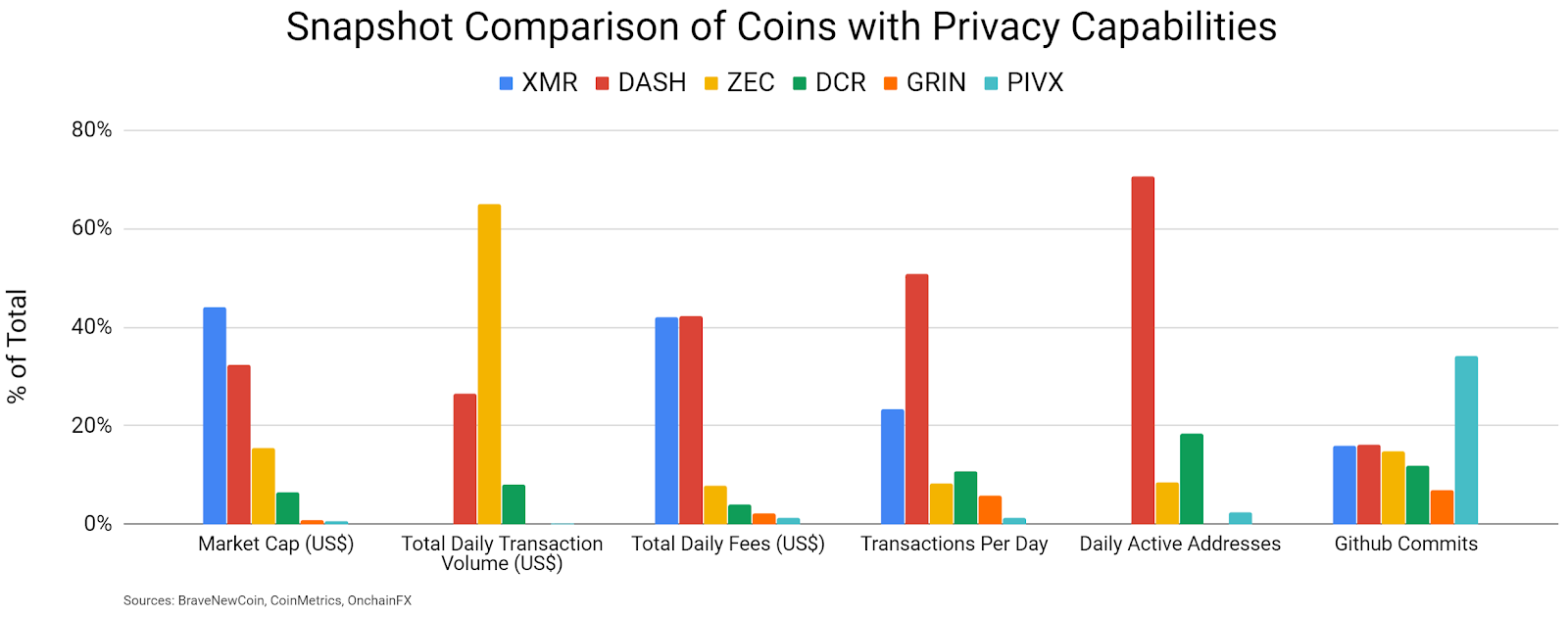
MLSAG signatures, as used by Shen Noether's RCT, are based on Gregory Maxwell's Confidential Transactions, and Nicolas van Saberhagen's Ring Signatures. These digital signatures allow any member of a group to produce a signature on behalf of the group, without revealing the individual signer's identity.
RCT was initially implemented on XMR in January 2017 and improves upon ring signatures by allowing hidden transaction amounts, origins, and destinations with reasonable efficiency and verifiably trustless coin generation. A stealth address feature gives additional transaction privacy by allowing for single-use addresses, which only reveal where a payment was sent to the sender and receiver. A multi-signature wallet function in the native XMR wallet was also implemented in April 2018.
A drawback of a hidden ledger is the inability to audit the chain to determine if extra coins have been minted. In July 2019, HackerOne revealed several vulnerabilities, including the ability to send counterfeit XMR to an exchange wallet. The report stated, “by mining a specially crafted block that still passes daemon verification, an attacker can create a miner transaction that appears to the wallet to include a sum of XMR picked by the attacker...this can be exploited to steal money from exchanges.”
The bug did not affect on-chain XMR values and the vulnerability was patched months before the HackerOne report. ZEC had a similar but worse on-chain minting problem with an inflation bug that went without a fix for eight months.
XMR’s transactional privacy features have also attracted increased mining malware and ransomware operators over the past few years. A report released in January 2019 found that nearly 5% of all XMR in existence was created by crypto-mining malware.
There have been several malware variants affecting different operating systems. KingMiner, targeting Windows servers, likely accounted for an 86% increase in crypto-jacking throughout Q2 2018, as reported by McAfee labs. Linux.BtcMine.174, which targeted old Linux operating systems, was discovered in November 2018. Mining malware affecting cloud providers using Linux was found in January 2019 by Palo Alto Networks Unit 42. The Ukraine government was also affected by the crypto jacker Minergate.
Trend Micro has also reported a significant uptick in XMR-related mining malware since late 2018. This included two mining malware variants affecting Windows servers, RADMIN and MIMIKATZ, and Linux malware Coinminer.Linux.MALXMR.UWEIU which eliminated any competing malware on the infected machine. The security analysts also detected a URL that was spreading a botnet with an XMR miner bundled with a Perl-based backdoor component. The Perl-based backdoor component is capable of launching distributed denial-of-service (DDoS) attacks, allowing the cybercriminals to monetize their botnet through cryptocurrency mining and by offering DDoS-for-hire services. Most of the infection attempts thus far have occurred in China.
In response to the persistent and ongoing use of malicious software, the XMR community created a website to help users affected by these problems, including information for diagnosing and removing the malicious software. However, there are ongoing concerns around governmental attempts to declare a ban on XMR use. Japanese and U.S. governments have expressed interest in “legislative or regulatory actions” to prevent the use of privacy-focused cryptocurrencies, such as XMR and ZEC, for illicit purposes. UpBit delisted privacy coins in September 2019, and OKEx Korea remains in the process of discussing delisting these coins.
In late 2018, the U.S. Department of the Treasury’s Office of Foreign Assets Control (OFAC) blacklisted two specific Bitcoin addresses for the first time, both of which had been used for ransomware. In early 2019, OFAC blacklisted 10 BTC addresses and one LTC address connected to narco-trafficking. Earlier this month, several more BTC addresses were added to the OFAC list. These blacklisting procedures decrease coin fungibility and increase coin surveillance, both of which are not possible with XMR.
Riccardo Spagni, a member of Monero’s core developer team, has expressed his opinion that the U.S. is unlikely to declare privacy coins illegal. Spagni has stated that privacy coins will remain open to U.S. users as long as The Onion Router (TOR) remains open. He has also suggested that Zcash, which is managed by a U.S. company, is much more likely to be targeted by U.S. regulators.
There are two key XMR-related protocols, Tari and Kovri. Tari was announced in May 2018 and will introduce token creation, in a similar fashion to Colored Coins on Bitcoin, ERC20 tokens on Ethereum, and non-fungible tokens (NFTs) in general. Although there have been no recent announcements related to Tari, although the GitHub repository remains active.
Kovri, which is currently live, allows for wallet features that are similar to TOR by adding additional user privacy through anonymizing geographical locations and IP addresses with an overlay network. Eventually, all future XMR transactions will be routed through Kovri.
On the network side, the XMR community has taken an aggressive approach to regain Application Specific Integrated Circuit (ASIC) resistance. Beginning in late 2017, the XMR hash rate began to increase substantially, suggesting ASIC mining. This meant that CPUs and GPUs could no longer efficiently mine XMR due to ASIC competition. The increased use of ASICs on any chain can mean increased network centralization as less efficient hardware, like GPUs and CPUs, become unprofitable to use, allowing those with more resources to buy more ASICs.
The XMR Proof-of-Work (PoW) algorithm, CryptoNight, had been scheduled for slight changes through the use of periodic hard forks, every six months, which would have ideally decreased the use of ASICs on the chain. In an aggressive attempt to remove ASICs from the chain, the XMR community implemented a new PoW consensus algorithm, RandomX, via hard fork in late November. The new algorithm gives CPU mining a competitive advantage over both GPUs and ASICs.
Two further changes included; the removal of long payment IDs, where transactions require at least two outputs, and a ten-block lock time for incoming transactions. The goal of these changes is to improve privacy for the users and the network.
Since the hard fork and new consensus algorithm, hash rate has hit a new all-time high. However, a CryptoNight hash is not equivalent to a Random X hash, so these cannot be compared directly. An increase in hash rate since the hard fork does suggest increased mining interest on the chain.

Since the November 2019 hard fork, the hash rate appears to have increased in centralization based on hash rate distribution between each pool. Two pools currently control 60% of the hash rate on the network and four pools control 83% of the hash rate on the network. Over time, this distribution will likely even out as more and more pools and users switch to mining equipment advantageous for RandomX.
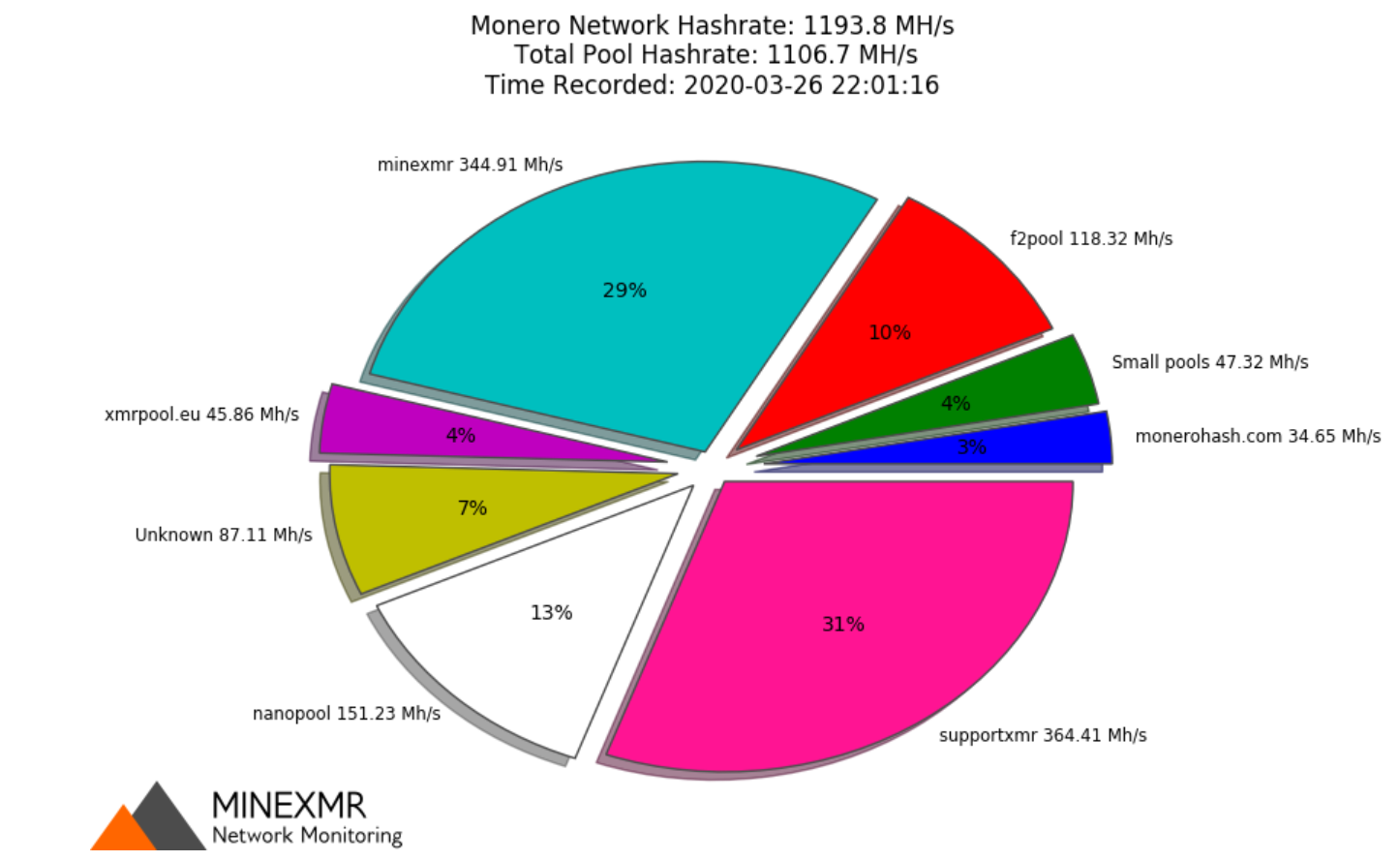
Just over 95% of the 18.4 million XMR to exist by May 2022 have now been mined. XMR has a two-minute targeted block time with a 2.54% annual inflation (line, chart below), which is among the lowest of all coins. When compared to the stepwise disinflationary curve which occurs after each Bitcoin block reward halving, XMR has a smoother emission curve until the block reward hits 0.3 XMR per minute, where it will remain indefinitely. This is known as tail emission and ensures a block reward in perpetuity, regardless of transaction fees.
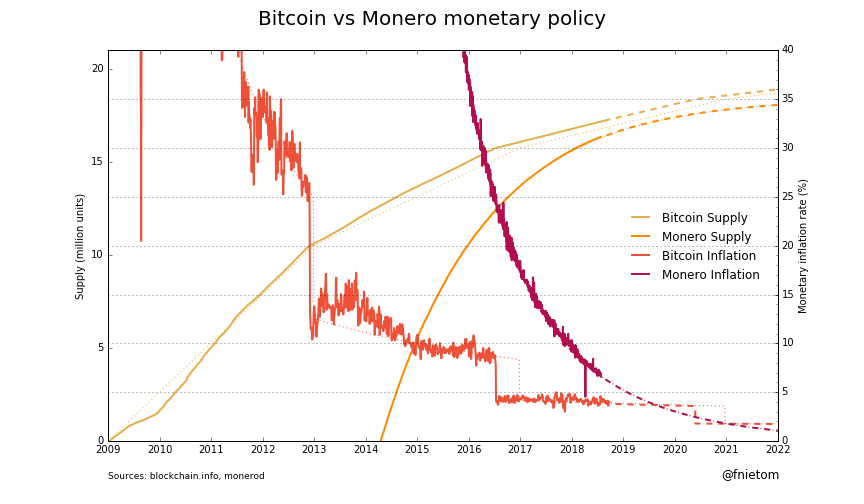
Transactions per day (line, chart below) on the Monero network have continued to increase since the November hard fork, now nearing all-time highs. Peaks in mining difficulty (fill, chart below) since January 2018 have preceded spikes in transactions per day, suggesting that mining activity may be a cause for this transaction spike. As mining malware activity or new ASICs come on or offline, mining difficulty can vary wildly.
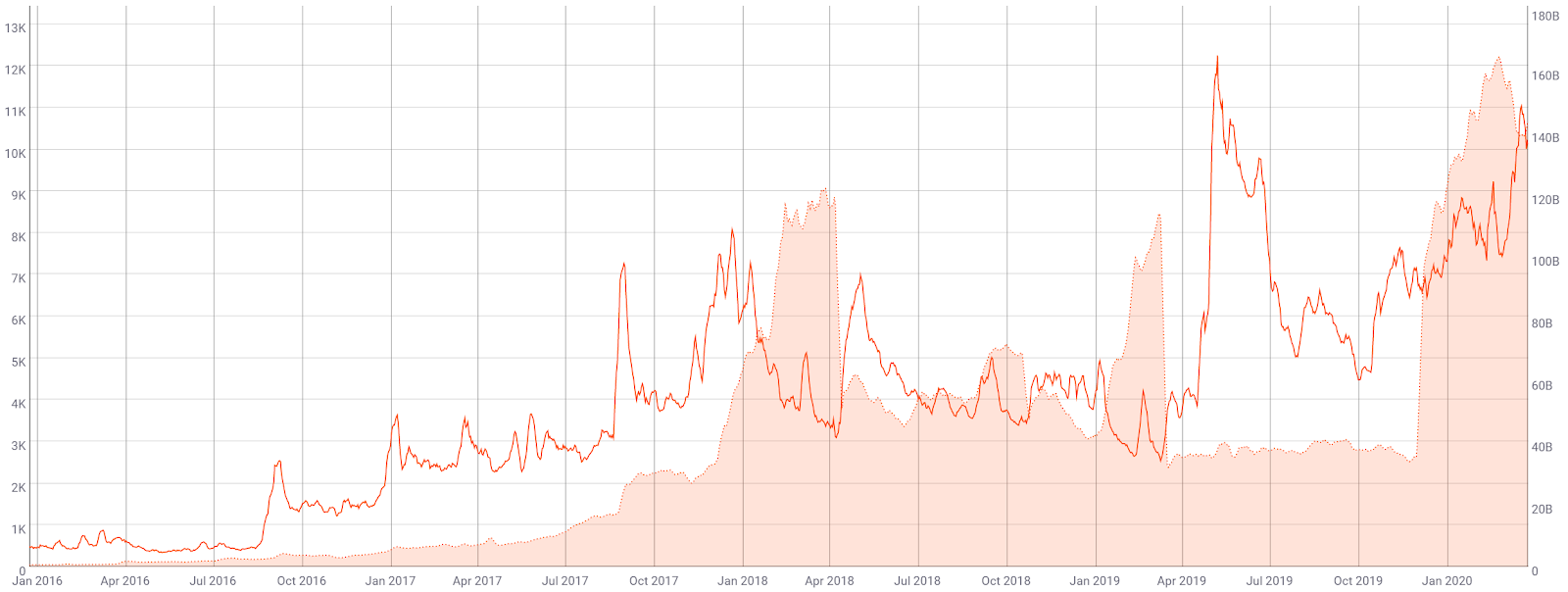
XMR historically led the pack in regards to average transaction fees (red, chart below). XMR transaction fees are currently US$0.0145, higher than DASH, ZEC, DCR, and GRIN, but lower than PIVX. XMR has also historically had more transactions per day than ZEC, GRIN, or PIVX, but fewer than DASH (not shown).
In October 2018, XMR completed a hard fork to implement Bulletproofs, which reduced transaction sizes by 80% and immediately brought average transaction fees down to US$0.027. XMR’s average daily block size is currently higher than DASH, ZEC, DCR, GRIN, and PIVX, and has also decreased significantly since the addition of Bulletproofs (not shown).
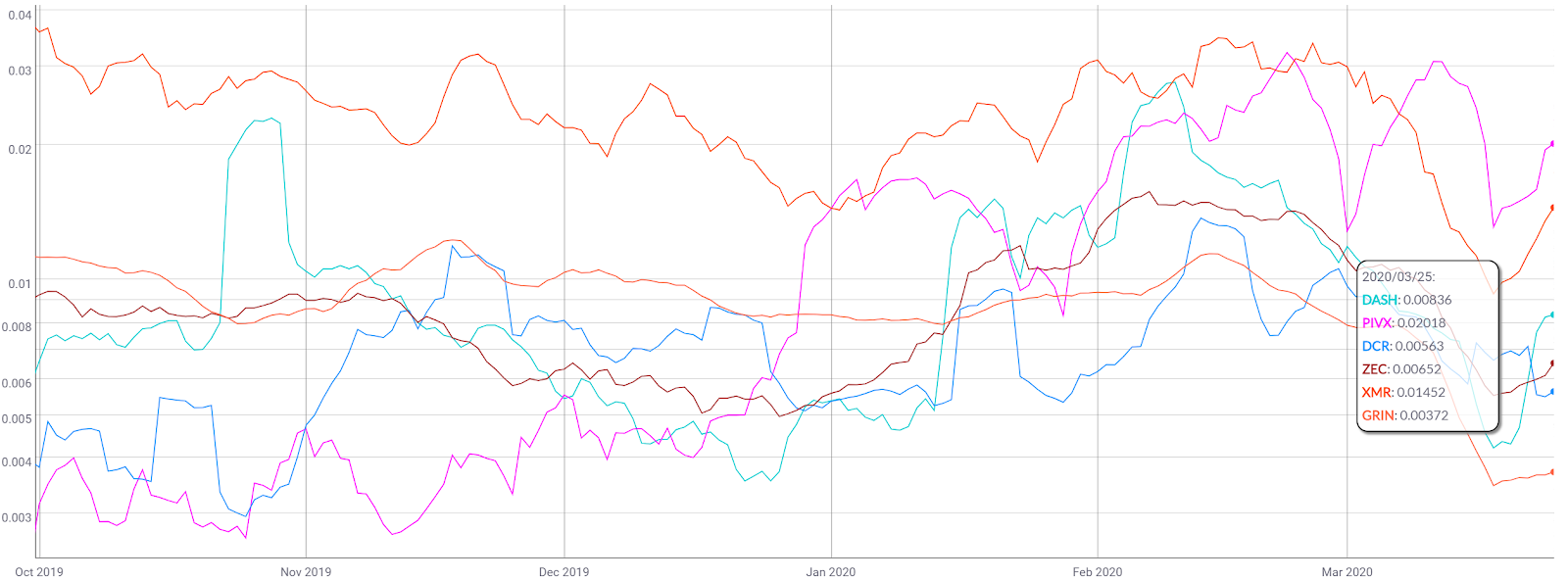
Turning to developer activity, XMR currently has 17 repos on GitHub. In total, over 200 developers have contributed over 3,000 commits in the past year across all repos. Most of these commits have occurred on the main XMR repo (shown below).
Most coins use the developer community of GitHub. Files are saved in folders called "repositories," or "repos." Changes to these files are recorded with "commits," which save a record of what changes were made, when, and by who. Although commits represent quantity and not necessarily quality, a higher number of commits can signify higher dev activity and interest.


Exchange-traded volume has been led by Bitcoin (BTC) and Tether (USDT) markets with most of the volume originating from Huobi and Binance. The dominance of the BTC trading pair is largely due to the lack of direct fiat gateways for XMR.
Throughout 2019, several monero pairs were added to various exchanges; Binance added XMR/BNB and XMR/USDT trading pairs; XMR/BTC margin trading was added to Poloniex in late April; BTSE added XMR/BTC, LTC, ETH, USDT, USDC, TUSD, and a variety of other fiat pairs in October. In September, Poloniex delisted LTC/XMR, DASH/XMR, ZEC/XMR, MAID/XMR, NXT/XMR, and BCN/XMR pairs due to low volume. Poloniex also added an XMR/USDT margin pair earlier this week.
As exchange services like Shapeshift require customers to register for KYC/AML compliance, XMR volume on decentralized exchanges (DEXs) will likely continue to increase. The XMR/BTC pair on Bisq, a peer to peer private DEX, currently accounts for 70% of the total exchange volume. In 2018, the U.S. Securities and Exchange Commission began requiring DEX owners to register as exchanges, which may keep unregistered DEXs out of the U.S. entirely.
In the future, XMR may be delisted from centralized exchanges and relegated to DEXs only. Although, in August 2018, XMR was listed as a potential addition to Coinbase. ZEC was added to Coinbase with its optional privacy feature disabled. Hardware wallet solutions currently available for XMR include the Trezor Model T and the Ledger Nano S.
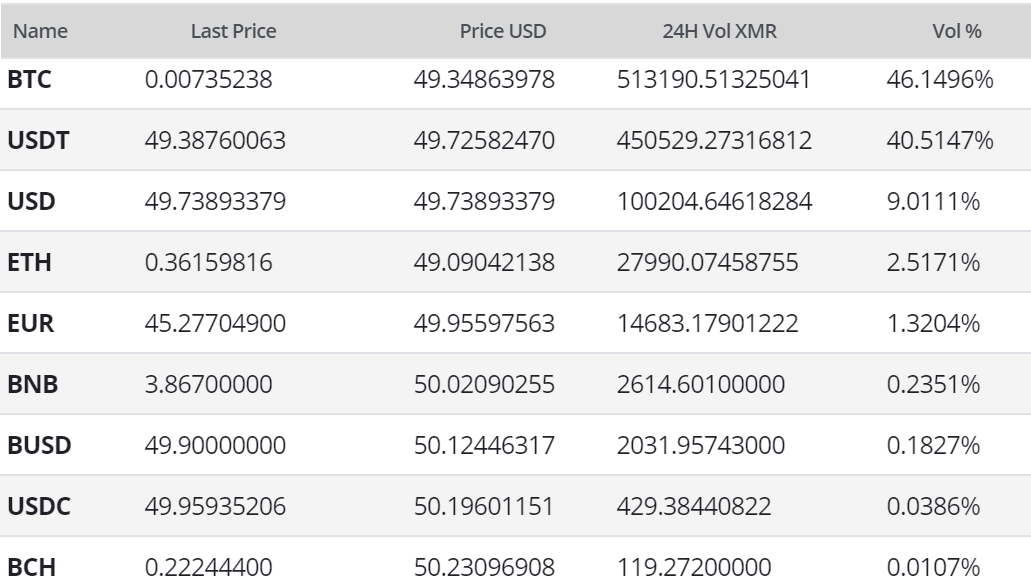
Worldwide Google Trends interest regarding the term "Monero" remained sharply down over the course of 2018 to present. A slow rise in searches for "Monero'' preceded the bull run in Q4 2017, likely signaling a large swath of new market participants at that time. A 2015 study found a strong correlation between the google trends data and bitcoin price, while a 2017 study concluded that when the U.S. Google "Bitcoin" searches increase dramatically, Bitcoin price drops.

Technical Analysis
A potential roadmap for future price action can be found using Exponential Moving Averages, Volume Profile Visible Range, Pitchforks, the Relative Strength Index, and the Ichimoku Cloud. Further background information on the technical analysis discussed below can be found here.
On the daily chart for the XMR/USD market, the 50-day exponential moving average (EMA) and 200-day EMA Golden Cross occurred in early February, followed by a Death Cross on March 12th. The spot price also recently broke below the large Volume Profile Visible Range (VPVR) node between US$43 and US$57. Further consolidation in this zone is likely necessary before a retest of higher highs.
Further, long/short open interest on Bitfinex (top panel, chart below) is currently 71% long, with long positions decreasing during the recent price drop. Additionally, there are currently no active volume or RSI divergences to suggest weakening bearish momentum. However, RSI hit 18 on march 12th, the second lowest level on record.
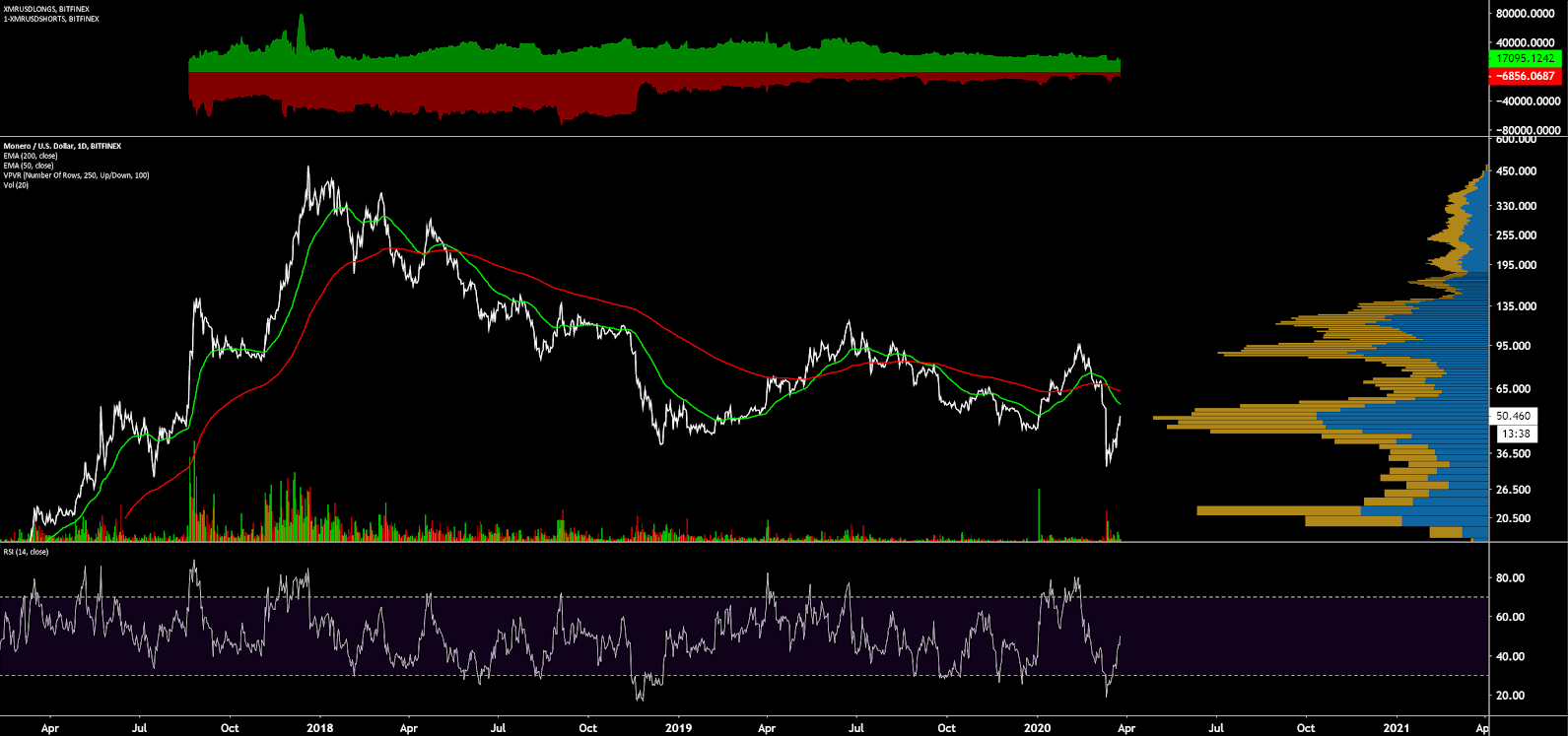
Turning to the Ichimoku Cloud, four metrics are used to determine if a trend exists; the current price in relation to the Cloud, the color of the Cloud (red for bearish, green for bullish), the Tenkan (T) and Kijun (K) cross, and the Lagging Span. The best trade entry always occurs when most of the signals flip from bearish to bullish, or vice versa.
Cloud metrics on the daily time frame with doubled settings (20/60/120/30), for more accurate signals, are bearish: the current spot price is below the Cloud, the Cloud is bearish, the TK cross is bearish, and the Lagging Span is below the Cloud and below the spot price. The most prudent long entry will take place once the spot price is above the Cloud with a bullish TK cross, otherwise, the trend will likely remain bearish. The spot price is currently 20% below the Kijun, suggesting oversold conditions.
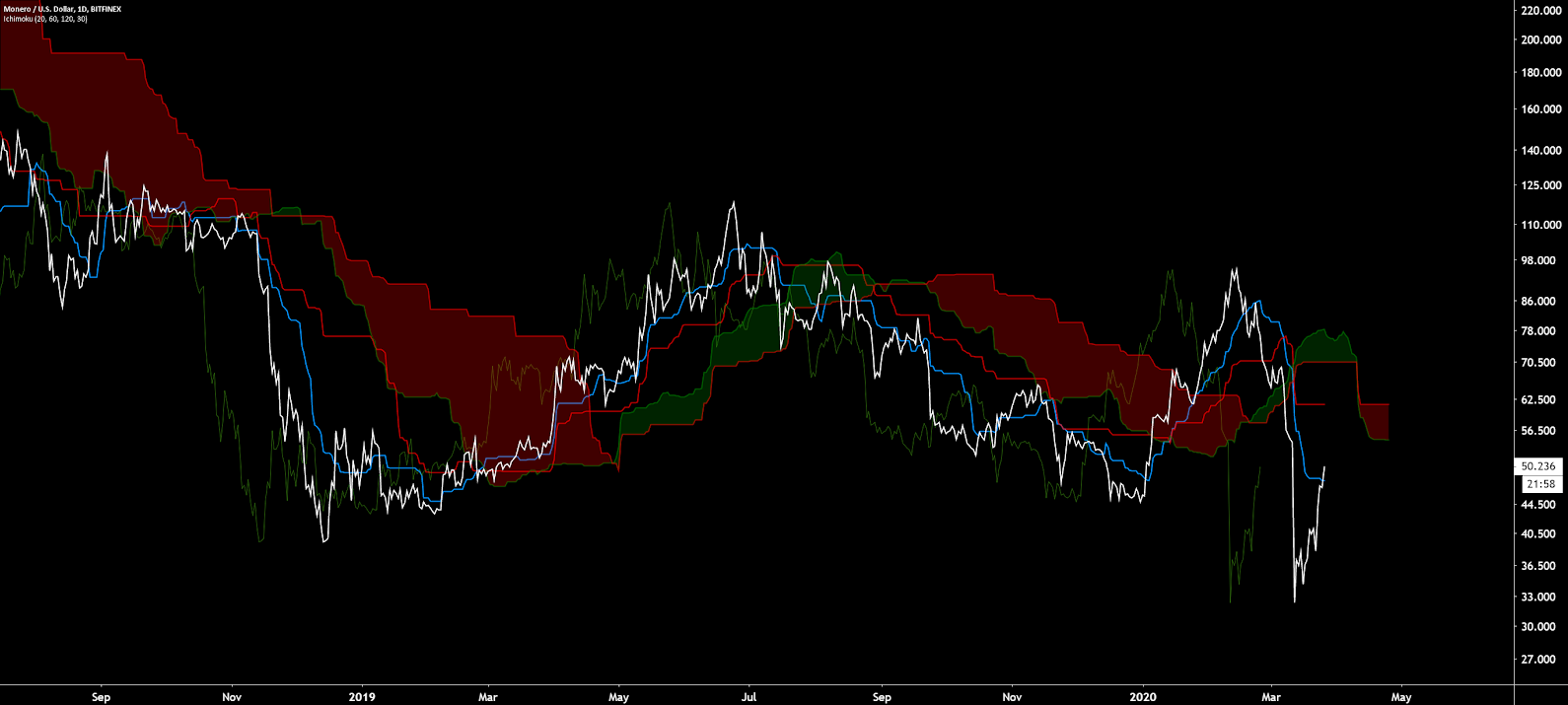
Lastly, on the XMR/BTC daily chart, the trend remains neutral. The 50-day EMA and 200-day EMAs briefly crossed bullish, for the first time in nearly 630 days. The spot price also briefly definitively held above the Cloud for the first time since early 2018. The most prudent long entry will take place once the spot price is above the Cloud with a bullish TK cross, otherwise, the trend will likely remain neutral. VPVR suggests significant overhead resistance at the psychological resistance of 0.01 BTC. A recent bullish divergence on RSI suggests waning bearish momentum.
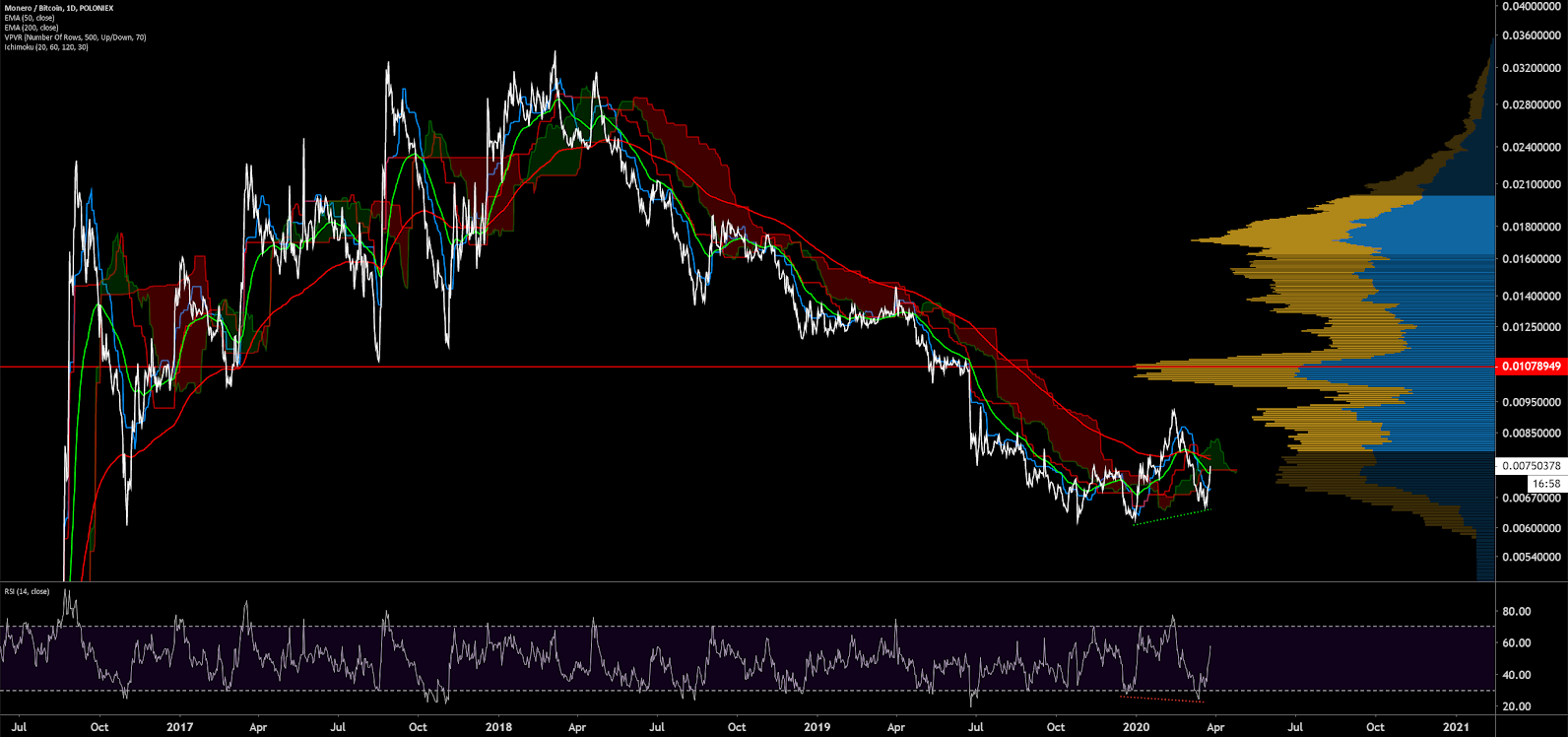
Conclusion
Fundamentals show active and continued incremental XMR network upgrades over the past two years, including decreased transaction costs, improved transaction efficiency, blockchain pruning, improved privacy, and improved custody solutions. Transactions per day have recently returned to all-time high levels with inflation around 2.54% annually.
In November 2019, the network changed from the CryptoNight consensus algorithm to Random X. The goal of the new algorithm is to help remove ASIC mining from the network permanently, by giving CPUs a competitive mining advantage. Thanks to XMR’s ironclad privacy, darknet traffic continues to thrive due to new mining malware and various other attack vectors pointed at the Monero community, including, briefly, on Monero’s official website.
Technicals for the XMR/USD pair are bearish. The 50-day EMA and 200-day EMA crossed bearish on March 12th due, in alignment with the marketwide selloff. Price has also dropped below the Cloud but has re-entered a high volume area between US$43 and US$57, where a new range is likely to be established. Technicals for the XMR/BTC pair are neutral. Despite the large pullback, price did not make a lower low, but did definitively end the existing bullish trend. In the near term, price will likely continue to range from 0.0065 BTC to 0.0086 BTC, with a longer term consolidation zone of 0.01 BTC.
OhNoCrypto
via https://www.ohnocrypto.com
Josh Olszewicz, Khareem Sudlow
